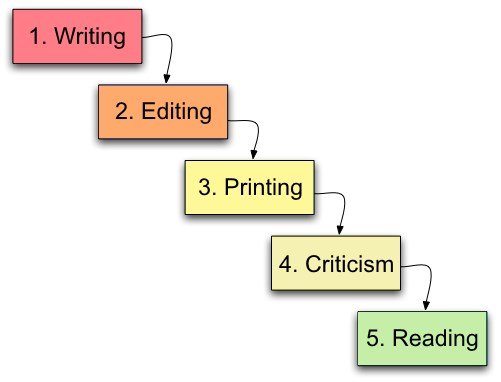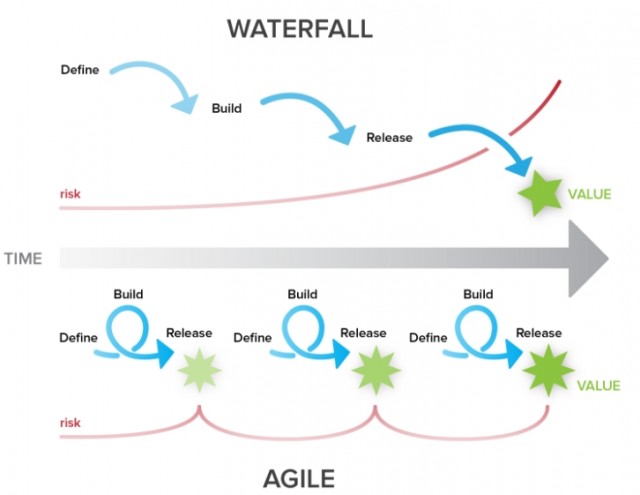How to write a best-seller and transform it to Oscar-winning script
The own readership community helps the author to write and promote a book and a script.
Table of Contents
Part 1. Writing Models
Waterfall model
Traditionally, a waterfall model is used to release the book. The release of the book is divided into successive stages. A new stage begins only after the complete end of the previous one:
- The writer writes a book
- Editor edits
- Publisher publishes
- Critics rate
- Readers buy
Model of a waterfall:

Progress flows from top to bottom, like a cascading waterfall:

Return to the previous stage is not possible.
In the model of a waterfall, the writing experience is gained with the writing of many books. A frequent tip for beginning writers: “Finish the first book - start the next one right there. By the 10th book, you will learn how to write books that are interesting to readers.”
Agile
In 2009, writer Andy Weir began writing the novel The Martian. He was a programmer and applied the Agile development model for writing.
Andy Weir writes in an essay:
“I originally wrote "The Martian" as a free serial novel, posting one chapter at a time to my website. I had a small but loyal following of readers who read each chapter as I finished it. This turned out to be an amazing process. I got tons of feedback as the story progressed, and I fine-tuned the novel as I went along.”
Agile technology ensured the success of the Martian novel:
- each chapter received community feedback right after writing
- the main thing was not following the book’s plan, but the satisfaction of its readership
- at any given time, all published chapters were approved by the community and well-edited by the author.
Waterfall model vs Agile
The difference between Waterfall model and Agile:

In the article “Standish Group 2015 Chaos Report - Q&A with Jennifer Lynch” compare the success of 50 thousand projects. They were implemented by the waterfall and Agile models.
Both models work well with small projects:
- Waterfall model brings 44% success
- Agile brings 58% success.
As the size of projects grows, risks increase, success comes less and less. The advantage of Agile becomes apparent for large projects:
- Waterfall model: 3% success
- Agile model: 18% success.
For writers, the difference between the waterfall model and Agile is even greater.
The waterfall model is popular among amateur writers. The famous NaNoWriMo contest (National Novel Writing Month) on the model of a waterfall. Contestants must write a novel in one month. Since 2006, about 400 NaNoWriMo novels have been published via traditional publishing houses. This is approximately 30 novels per year. In 2015, the contest participants wrote 40 thousand novels. The Waterfall model brings success to only one writer out of a thousand, the chance to publish a novel is only 0.1%.
The success of Agile novels is dramatic. Andy Weir writes about the fate of his novel The Martian after being posted on Amazon:
“After that, things got a little crazy. Next thing I knew, it was one of Amazon’s top five sci-fi bestsellers, and tens of thousands of people had downloaded it. Then a literary agent and publishers came knocking, and movie studios started bidding on the film rights. And now, it’s going to be hitting bookstore shelves not just in the U.S., but in 18 other countries.”
Publishers have also long been taking advantage of the Agile model. Well-known writers write a book by chapter in close collaboration with the editors. The customer (publisher) makes suggestions as the book is written. This is Agile. The chances of publishing a novel are almost 100%.
You do not have a contract with the publisher and your editor? Build your readership community. It will serve as an editor and many others.
Part 2. Own readership
Andy Weir used the blog to publish another chapter. The blog limits the ability of subscribers. They can only criticize published chapters in the comments.
The term “Web 2.0” refers to projects and services that are actively developed and improved by the users themselves: blogs, wikis, social networks, etc.
According to the concept of Web 2.0, a writer can entrust the reader community with far more responsibilities than criticism alone.
Editing a book
The author publishes the next chapter of the book as a wiki article. The reader community edits the chapter and all inconsistencies in previous chapters. The community creates rules for editors like Wikipedia rules.
Editing a book does not make the community a co-author of the book. The writer is still the author. In case of some contention disagreements, the writer reserves the last word.
The author regularly holds online meetings with his community and discusses the plan for the next chapter.
When the last chapter of the book is published, the community switches to promoting the book.
Starting feedbacks and purchases on Amazon
The community determines the price at which most participants are willing to buy a book. The author publishes the book on Amazon in electronic form.
Community members buy one copy of the book and leave positive reviews (customer reviews). All customer reviews are marked as “Verified Purchase”.
Every day, the community members check new positive feedbacks and click the Helpful button under them.
The participants ask their friends to buy a book and appreciate it.
Participants publish video reviews of the book.
Amazon keeps the track of the great reader interest in the book. It comes to the top of it’s category. Potential readers will see many customer reviews from Verified Purchaser readers. They buy a book and write their customer reviews.
The printed version of the book
All agents and publishers are keeping a close eye on the latest in Amazon tops. They hurry up to offer the author cooperation with them.
The publisher provides a professional editor to finalize the book. The readership community:
- has access to all correspondence between the author and the editor of the publishing house
- participates in online meetings of the writer with the editor of the publishing house
- rewrites the book with the writer and editor.
The communicating with the publisher's editor enhances the skills of the writer and community editors. They better understand how to write the next book.
The various publications of the book
On the writer's site, the book is published in the community edition. Each chapter has a lot of additional information:
- the links to the other sites
- the pictures and videos illustrating some of the concepts in the chapter
- the paragraphs with explanations hidden in the spoiler
- the correspondence of the community in the comments.
Community converts community edition to other editions:
- electronic edition
- print edition
- audio edition
- movie script
- comics-book
- game scenario
The author is trying to sell all the editions. The editions that are difficult to sell, the author uses to promote the book.
Translations into other languages
Amazon supports 7 languages. A strong readership has native speakers of all languages. They translate the main editions of the book from English into other languages. First of all, the community translates the electronic edition and audio-edition.
Book tour in the cities
The publishing house and the readership community organize a writer-wide tour of the city for the writer.
The writer meets new readers in a large bookstore in every city. He signs books for them. A community member signs them up immediately for the community news. The community gets new members.
In the evening, the writer meets with all the members of his community from this city. The video of the meeting is broadcasting` on the community website.
Fan meeting
The community selects the city for the fan convention and draws up a program.
The community selects some participants with the experience in video blogging. They organize a video broadcast of the fan meeting, take interviews, publish videos on the site.
Fan fiction
The community helps its members to create fanfictions, fanart, fanmovies, fungames, fancomics, and fansongs based on their books. They are published on the readership site.
Shooting a movie from a book
Sales of the novel are growing. Hollywood buys the rights to the film version of the book. A professional screenwriter helps the writer and his community create the Oscar-winning script.
During the casting, the community expresses its opinion on the choice of actors.
While the set, the community has a residential caravan (mobile home). The community video bloggers take turns visiting the set for 2-3 days. They wear a vest with the official inscription “Movie Blogger”. Video bloggers shoot the process of creating a movie, interview film crew members, and take part into the film crew parties. The community video bloggers play some small roles in the film with a dialogue.
The more the community participates in the scripting and filming process the greater the interest to the film becomes. New members join the community.
The writer and his community start better understand the specifics of video filming and how to write a script.
The release of the movie on the book
After the release of the film, the community of the book receives new members from among those who saw the film. They buy a book, watch the video about the story of the film making.
A new book
The publisher concludes a contract with the writer for a new book. The writer, his experienced community, and the editor of the publisher starts writing a new book.
Part 3. The main object of the writer
In the 21st century, the main object of a writer is not to write books by only himself.
The writer must use each step of writing a book to increase and educate his community. After the publication of the book, the writer continues growing and increasing his community. So the writer comes to the beginning of writing the next book with a large experienced community.
Which guarantees:
- the success of the new book
- the account in the book of the specifics of the audio version and the movie
- the increased cost of the contract with the publisher and film studio.
Part 4. References
I’ve made 2 lists of free programs. They will help you build your own readership.
Software for a small community in the Andy Weir style:
- Typesetter CMS, blog, comments, private pages, mailing list
- Google Docs, edit files online while collaborating with other users in real-time.
Software for a large community:
- Drupal community site - blog, wiki, forum, book, multilingual chapter versions, comments
- SuiteCRM, client relationship management
- Mautic, marketing automation
- Slack, a messenger for the community
- Trello, project management service
- Calendly, appointment service
- Doodle, online calendar tool for time management, and coordinating meetings
- Zoom, online meeting service
- Surveymonkey, voting service.
Part 5. Practice
"Sometimes, Seeing Is Believing." I am growing two readership communities. Feel free to use for your practice.
You can:
- See with your own eyes how the readership is being built from scratch
- Learn online community building software
- Get practice in building a community.
Then you will begin to grow your own community of readers.
Choose the appropriate one and subscribe:
